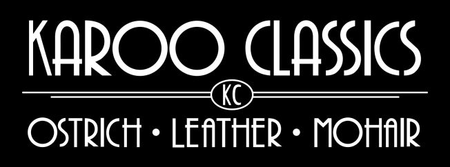We also do Mohair!
We are More than Just Ostrich Leather…
So now you are wondering what else do we do… If you have not visited one of our stores in Stellenbosch or Franschhoek, South Africa, then we are delighted to let you know we also have a gorgeous Mohair collection.
But let’s tell you a bit about Mohair, it is quite a good read!
Mohair is a fabric or yarn made from the hair of the Angora goat (not to be confused with the Angora rabbit, which produces Angora wool). Both durable and resilient, mohair is notable for its high lustre and sheen, and is often used in fibre blends to add these qualities to a textile such as wool. Mohair takes dye exceptionally well. It feels warm in winter as it has excellent insulating properties, while its moisture-wicking properties allow it to remain cool in summer. It is durable, naturally elastic, flame-resistant and crease-resistant. It is considered a luxury fibre, like cashmere, angora, and silk which can be more expensive than most sheep's wool.
Mohair is composed mostly of keratin, a protein found in the hair, wool, horns and skin of all mammals, but mohair's special properties are unique to the Angora goat. While it has scales like wool, the scales are not fully developed, but merely indicated. Thus, mohair does not feel the same way common or standard wool does.
Mohair fibre is approximately 25 – 45 microns in diameter. It increases in diameter with the age of the goat, growing along with the animal. Finer, softer hair from younger animals is used (for example) in scarves and shawls; the thicker, coarser hair from older animals is more often used for carpets and in heavy fabrics intended for outerwear.
The term mohair is sometimes used to describe a type of material used for the folding roof on convertible cars. In this instance, mohair refers to a form of denim-like canvas.
What about the production of Mohair?
With regards to production, the Angora goats are sheared twice a year, in the spring and in the fall. One goat will produce 11 to 17 pounds (5–8 kg) of mohair a year. Shearing is done on a cleanly-swept floor and extra care is taken to keep the hair clean and free of debris. The hair is then processed to remove natural grease, dirt and vegetable matter. Mohair grows in uniform locks. The Angora goat is a single-coat breed, and unlike pygora or cashmere, there is no need to dehair a mohair fleece to separate the coarse hair from the down hair.
Interestingly enough, South Africa is the world's largest mohair producer as of 2013, supplying around 50% of the total world production. Mohair is one of the oldest textile fibres in use. The Angora goat is thought to originate from the mountains of Tibet, reaching Turkey in the 16th century. However, fabric made of mohair was known in England as early as the 8th century. The word "mohair" was adopted into English sometime before 1570 from the Arabic word mukhayyar, a type of haircloth.
As of 2009, world output of mohair was estimated at around 5,000 tonnes a year, down from a high of 25,000 tonnes in the 1990s. South African mohair is generally exported raw or semi-processed to textile makers in Europe, the UK and the Far East. Prices for adult mohair declined in 2010 while prices for kid mohair remained the same. An emerging market for mohair producers has been China.
What is Mohair used for?
Mohair is used in scarves, winter hats, suits, sweaters, coats, socks and home furnishing. Mohair fibre is also found in carpets, wall fabrics, craft yarns, and many other fabrics, and may be used as a substitute for fur. Because its texture resembles fine human hair, mohair is often used in making high grade doll wigs or in rooting customized dolls.
Mohair is a very soft yarn when compared with other natural and synthetic textures. Due to mohair's lacking prominent, protruding scales along the hair's surface, it is often blended with wool or alpaca. Blending the heavily scaled wool helps the smooth mohair fibres hold their shape and stick together when spun into yarn. Mohair is also valued for certain other unique characteristics: it is warmer than other materials, even when used to make a light-weight garment, and is often blended with wool for this reason. Mohair fibres have a distinctive lustre created by the way they reflect light. Combined with mohair's ability to absorb dyes exceptionally well, pure mohair yarns are usually recognizable for their vivid, saturated colours.
Fibres from young goats are the softest and are used to manufacture yarn for clothing. Fibres from mature goats are used to produce such things as rugs and carpets. Mohair is also used in 'climbing skins' for Randonnée skiing and ski touring.
So what is our conclusion - South Africa has plenty to offer… So much more than just Ostrich leathers – be sure to visit us on your next trip to South Africa and buy yourself that beautiful Mohair product from Karoo Classics!
Sample Block Quote
Praesent vestibulum congue tellus at fringilla. Curabitur vitae semper sem, eu convallis est. Cras felis nunc commodo loremous convallis vitae interdum non nisl. Maecenas ac est sit amet augue pharetra convallis nec danos.
Sample Paragraph Text
Praesent vestibulum congue tellus at fringilla. Curabitur vitae semper sem, eu convallis est. Cras felis nunc commodo eu convallis vitae interdum non nisl. Maecenas ac est sit amet augue pharetra convallis nec danos dui.
Cras suscipit quam et turpis eleifend vitae malesuada magna congue. Damus id ullamcorper neque. Sed vitae mi a mi pretium aliquet ac sed elitos. Pellentesque nulla eros accumsan quis justo at tincidunt lobortis denimes loremous. Suspendisse vestibulum lectus in lectus volutpat, ut dapibus purus pulvinar. Vestibulum sit amet auctor ipsum.
